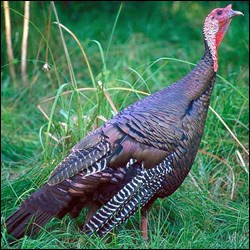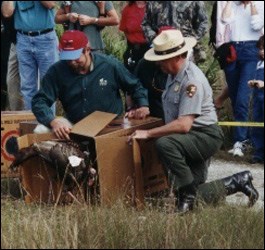
European explorers took Wild Turkeys from Mexico to Europe in the early 1500s. They were so successfully domesticated in Europe that English colonists brought them back with them when they settled on the Atlantic Coast. The domestic form has retained the white tail tip of the original Mexican subspecies, and that character can be used to distinguish wandering barnyard birds from Wild Turkeys, which have chestnut-brown tail tips. The Wild Turkey was an important food animal to Native Americans, but the species was eliminated from much of its range by the early 1900s. Attempts to use game farm turkeys for reintroduction programs failed. In the 1940s, wild birds were caught and transported to new areas, where they quickly became established and flourished and even expanded their range into new territory. Such transplantations have been responsible for the spread of the Wild Turkey to 49 states. Alaska is the only state without Wild Turkeys. The Florida Wild Turkey (Meleagris gallopavo osceola), an upland species that inhabits pinelands, cypress swamps, prairies, and hardwood hammocks in southern Florida, was extirpated from the Long Pine Key region of Everglades National Park in the early 1900s. Wild Turkey and six other upland species disappeared shortly after a dramatic reduction in area of the Atlantic rock ridge pinelands and extensive logging in the region. Hunting almost certainly contributed to the turkey's disappearance because of its establishment as a popular game bird. Efforts to reestablish a population of Wild Turkey in Everglades National Park were initiated in 2000. 
NPS photo Historical records suggest that several unsuccessful and unofficial efforts to reintroduce turkeys to the region took place between the late 1940s and early 1970s. A cooperative effort to restore the Wild Turkey to Everglades National Park was organized in the fall of 1999 because in addition to hunting now being illegal, a natural fire regime was being restored and the forests had recovered from logging. In January 2000, 29 Wild Turkeys (22 females and 7 males) captured from locations in southern and central Florida were released on Long Pine Key, 10 of which were fitted with radio transmitters. Subsequent monitoring to evaluate the success of the release yielded mixed results. Seven of the 10 (70 percent) radio-tagged turkeys died within a year after release, three of which were found in the Hole-in-the-Donut, an area of the park dominated by the exotic Brazilian pepper (Schinus terebinthifolius). The cause of death was unclear, but evidence suggests that predation was a major factor. On a good note, however, breeding was documented in 2001 in at least two locations and in 2005 at least one of the originally released turkeys was still alive. Unfortunately, a comprehensive camera survey in 2005 found a very small population with a sex ratio strongly skewed toward males. Possible explanations include too few birds initially released and effects associated with small populations, such as the low probability of encountering a potential mate. In 2006, a second release of 31 Wild Turkeys (20 females, 11 males) was conducted. Initial data collected from camera surveys, radio-tracking, and wildlife observations indicated that the second release of turkeys into Long Pine Key was successful. Successful breeding was reported in 2006 and 2007. Recent camera surveys in 2008 and 2009, however, indicate a reduction in population size, and few observations of successful breeding have been reported. Long-term success of the reintroduction will ultimately be determined by the development of a viable self-sustaining population. ADDITIONAL RESOURCES South Florida Multi-Species Recovery Plan |
Last updated: October 17, 2017
